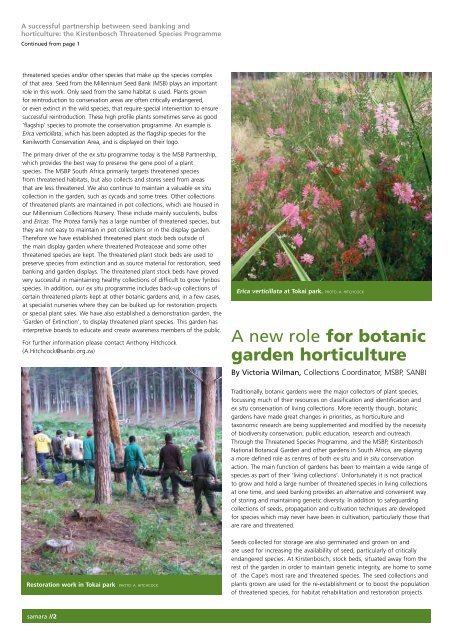A successful partnership between seed banking and horticulture:
A successful partnership between seed banking and horticulture:
A successful partnership between seed banking and horticulture:
You also want an ePaper? Increase the reach of your titles
YUMPU automatically turns print PDFs into web optimized ePapers that Google loves.
A <strong>successful</strong> <strong>partnership</strong> <strong>between</strong> <strong>seed</strong> <strong>banking</strong> <strong>and</strong><br />
<strong>horticulture</strong>: the Kirstenbosch Threatened Species Programme<br />
Continued from page 1<br />
threatened species <strong>and</strong>/or other species that make up the species complex<br />
of that area. Seed from the Millennium Seed Bank (MSB) plays an important<br />
role in this work. Only <strong>seed</strong> from the same habitat is used. Plants grown<br />
for reintroduction to conservation areas are often critically endangered,<br />
or even extinct in the wild species, that require special intervention to ensure<br />
<strong>successful</strong> reintroduction. These high profile plants sometimes serve as good<br />
‘flagship’ species to promote the conservation programme. An example is<br />
Erica verticillata, which has been adopted as the flagship species for the<br />
Kenilworth Conservation Area, <strong>and</strong> is displayed on their logo.<br />
The primary driver of the ex situ programme today is the MSB Partnership,<br />
which provides the best way to preserve the gene pool of a plant<br />
species. The MSBP South Africa primarily targets threatened species<br />
from threatened habitats, but also collects <strong>and</strong> stores <strong>seed</strong> from areas<br />
that are less threatened. We also continue to maintain a valuable ex situ<br />
collection in the garden, such as cycads <strong>and</strong> some trees. Other collections<br />
of threatened plants are maintained in pot collections, which are housed in<br />
our Millennium Collections Nursery. These include mainly succulents, bulbs<br />
<strong>and</strong> Ericas. The Protea family has a large number of threatened species, but<br />
they are not easy to maintain in pot collections or in the display garden.<br />
Therefore we have established threatened plant stock beds outside of<br />
the main display garden where threatened Proteaceae <strong>and</strong> some other<br />
threatened species are kept. The threatened plant stock beds are used to<br />
preserve species from extinction <strong>and</strong> as source material for restoration, <strong>seed</strong><br />
<strong>banking</strong> <strong>and</strong> garden displays. The threatened plant stock beds have proved<br />
very <strong>successful</strong> in maintaining healthy collections of difficult to grow fynbos<br />
species. In addition, our ex situ programme includes back-up collections of<br />
certain threatened plants kept at other botanic gardens <strong>and</strong>, in a few cases,<br />
at specialist nurseries where they can be bulked up for restoration projects<br />
or special plant sales. We have also established a demonstration garden, the<br />
‘Garden of Extinction’, to display threatened plant species. This garden has<br />
interpretive boards to educate <strong>and</strong> create awareness members of the public.<br />
For further information please contact Anthony Hitchcock<br />
(A.Hitchcock@sanbi.org.za)<br />
Erica verticillata at Tokai park. Photo: A. Hitchcock<br />
A new role for botanic<br />
garden <strong>horticulture</strong><br />
By Victoria Wilman, Collections Coordinator, MSBP, SANBI<br />
Traditionally, botanic gardens were the major collectors of plant species,<br />
focussing much of their resources on classification <strong>and</strong> identification <strong>and</strong><br />
ex situ conservation of living collections. More recently though, botanic<br />
gardens have made great changes in priorities, as <strong>horticulture</strong> <strong>and</strong><br />
taxonomic research are being supplemented <strong>and</strong> modified by the necessity<br />
of biodiversity conservation, public education, research <strong>and</strong> outreach.<br />
Through the Threatened Species Programme, <strong>and</strong> the MSBP, Kirstenbosch<br />
National Botanical Garden <strong>and</strong> other gardens in South Africa, are playing<br />
a more defined role as centres of both ex situ <strong>and</strong> in situ conservation<br />
action. The main function of gardens has been to maintain a wide range of<br />
species as part of their ‘living collections’. Unfortunately it is not practical<br />
to grow <strong>and</strong> hold a large number of threatened species in living collections<br />
at one time, <strong>and</strong> <strong>seed</strong> <strong>banking</strong> provides an alternative <strong>and</strong> convenient way<br />
of storing <strong>and</strong> maintaining genetic diversity. In addition to safeguarding<br />
collections of <strong>seed</strong>s, propagation <strong>and</strong> cultivation techniques are developed<br />
for species which may never have been in cultivation, particularly those that<br />
are rare <strong>and</strong> threatened.<br />
Restoration work in Tokai park Photo: A. Hitchcock<br />
Seeds collected for storage are also germinated <strong>and</strong> grown on <strong>and</strong><br />
are used for increasing the availability of <strong>seed</strong>, particularly of critically<br />
endangered species. At Kirstenbosch, stock beds, situated away from the<br />
rest of the garden in order to maintain genetic integrity, are home to some<br />
of the Cape’s most rare <strong>and</strong> threatened species. The <strong>seed</strong> collections <strong>and</strong><br />
plants grown are used for the re-establishment or to boost the population<br />
of threatened species, for habitat rehabilitation <strong>and</strong> restoration projects.<br />
samara //2
















